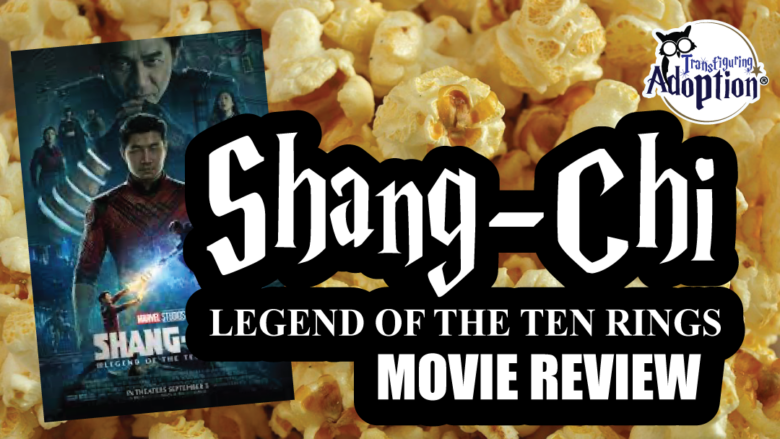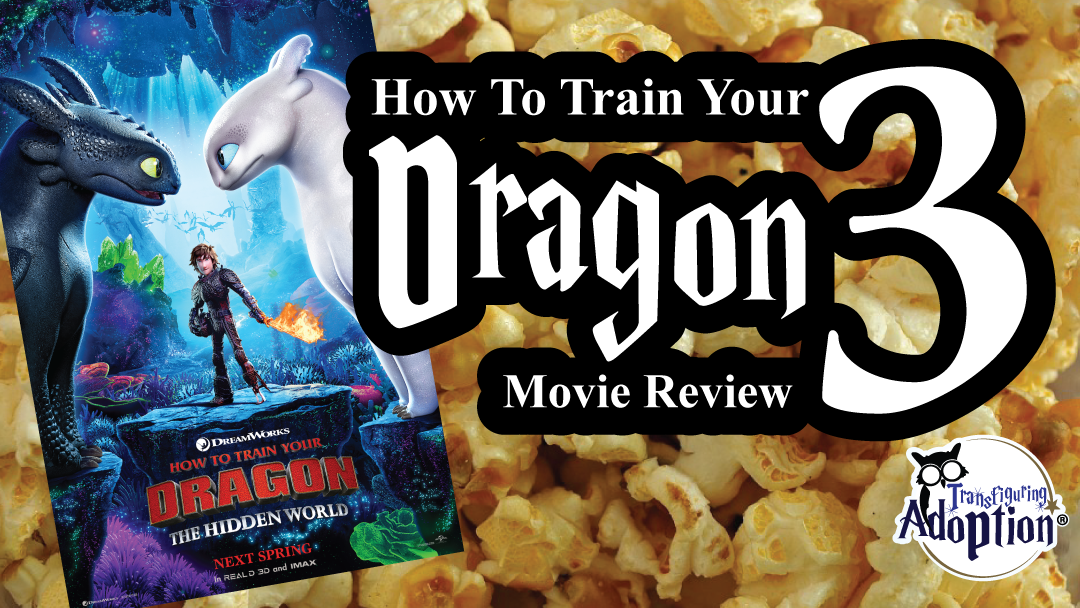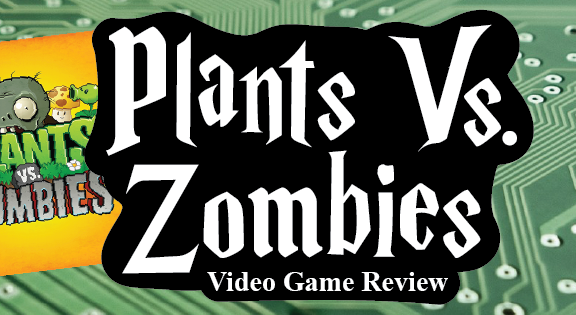Grade:
Transfiguring Adoption awarded this movie 3 Hoots out of 5 based on how useful it will be for a foster/adoptive family. [Learn more about our Hoot grading system here]
Movie Info:
-
Rating: PG-13 (Sequences of Violence & Action|Language)
-
Genre: Action, Adventure, Superhero
-
Runtime: 133 Minutes
-
Studio: Disney, Marvel Studios
From the Cover of Shang-Chi and the Legend of the Ten Rings by Marvel Studios:
“Marvel Studios’ Shang-Chi and The Legend of The Ten Rings stars Simu Liu as Shang-Chi, who must confront the past he thought he left behind when he is drawn into the web of the mysterious Ten Rings organization. The film also stars Tony Leung as Wenwu, Awkwafina as Shang-Chi’s friend Katy and Michelle Yeoh as Jiang Nan, as well as Fala Chen, Meng’er Zhang, Florian Munteanu and Ronny Chieng.”
Transfiguring Adoption’s Overview:
Shang-Chi and the Legend of the Ten Rings (2021) is the 25th movie in the Marvel Cinematic Universe (MCU), and that doesn’t even count the multiple Disney+ miniseries. But for those of you panicking because you don’t remember every detail of the previous films, don’t worry! Shang-Chi works really well as a standalone film and doesn’t require an in-depth knowledge of the MCU in order to enjoy it. There are however some fun cameos and references to other films that fans will enjoy, as is the Marvel way.
The film features a predominantly Asian cast, which is refreshing as it’s unusual for a superhero flick and a first for the MCU. Shang-Chi gives us a nice shake-up from the normal superhero movie. We still get a great balance of humor, action, and back story/character building that Marvel does so well, but there are also a lot of elements of martial arts movies, which is not something typically seen in the MCU. There are also some fantasy elements, so it’s an interesting blend of genres. However, it’s done in a way that feels well thought-out rather than cobbled together like it couldn’t decide what kind of movie it wanted to be. The film definitely sets up Shang-Chi to be one of the main superheroes of Phase Four and as a big Marvel fan myself, I’m excited to see where they take things from here!
The target age range is definitely older kids and teens, probably 10+ (depending on their maturity level). The PG-13 rating seems to be almost exclusively for violence and thematic content. Something else to bear in mind if watching with younger children or non-readers is that the entire opening sequence as well as a number of key dialogue moments throughout the film are spoken in Chinese with English subtitles. Also, given the amount of trauma Shang Chi and Xialing are dealing with (as seen in flashbacks throughout the movie) it’s one that you should strongly consider pre-screening before taking children or even teens with trauma backgrounds to go see.
** Spoilers Could Be Ahead **
How Is This Relevant To Adoption & Foster Care?
Shang-Chi and the Legend of the Ten Rings (2021) does not directly relate to foster care or adoption but does have a lot of themes that may be relevant. The title character Shaun/Shang-Chi lost his mother when he was very young and was brought up by his abusive father and is trained to be an assassin from a young age. He runs away when he is 14 but leaves behind his younger sister, something he feels guilty about. The movie follows his journey as he is forced to confront his past. Eventually he is able to work through some of his trauma and reconcile his past and biological family ties with his new life and found family and embrace his powers. Children who have experienced abusive family members or caregiver and sibling loss are likely to relate strongly to Shang-Chi’s experiences. These themes of confronting past trauma in order to heal, dealing with loss and grief, and found family are all things that children who have experienced trauma can relate to.
Discussion Points:
- Working Through Past Trauma to Create a Better Future
When he was 14 Shang-Chi was sent on an assassination mission and after he completed his mission, he chose not to return home to his abusive father and working as part of a terrorist organization. Instead, he changed his name to Shaun and ended up forming an incredibly close friendship with Katy and working as a hotel valet. Shaun wanted to escape his past and not be the person his father was trying to force him to be and this is something we see him struggle with throughout the film. In the end he’s able to combine the power of his father and gentle strength of his mother and find his own path that embraces his past and who he is but also allows him to make more positive choices. We learn that his father went on a similar journey: after meeting Li he gave up the Ten Rings and his power to live a peaceful life with his family, saying that Li had given him the hope that he could be a different man than he had been for the past 1000 years. However, after her death he was crippled with grief and guilt that he hadn’t been able to protect her and went back to his old life. This can be a great opportunity to compare their two journeys and what made Shang-Chi successful when his father wasn’t. Most children who have experienced trauma have things in their past they wish weren’t a part of them. But ignoring or running away from those things, while successful in the short term, isn’t a long-term solution. Rather than running away they need to confront and embrace their past in order to process their trauma and decide what they want their future to look like, just as Shang-Chi had to return home and face those parts of his childhood he was trying to push away before he could fully embrace his powers and make the life he wanted for himself. - Family is more than just Blood
After Shang-Chi ran away, he changed his name to Shaun and lived in San Francisco, building a new life for himself away from his father and the terrorist organization he runs. Along the way he met Katy, his best friend and found family. We see scenes of Shaun spending time with Katy’s family and he’s clearly very close with them. When he has to return home to deal with his sister and father Katy comes with him, despite finding out that Shaun had been lying to her about his past. She stands by his side even when that means traveling to another realm and facing a battle and monsters. Shang-Chi also chooses to protect and fight for Katy rather than just siding with his father despite the latter’s insistence of putting his ‘family’ aka ‘blood’ first. This can be a great way to talk about who’s important in your kiddo’s life — likely a combination of birth family, foster/adoptive family, and friends. - Dealing with Loss/Grief
The movie shows a lot of unhealthy ways to deal with grief and loss, but can still be a great starting point for opening up a conversation and talking about feelings your kiddos have around their own losses. After Shang-Chi’s mother died, his father got lost in grief, blaming himself for her death. As a result, he went back to being the assassin he used to be and running the Ten Rings terrorist organization. He also turned abusive towards both of his children – training Shang-Chi to be an assassin and refusing to acknowledge Xialing because she reminded him of his lost wife. Later, he is driven to madness by the Creature of Darkness because it is able to convince him he hears his deceased wife’s voice and he is so desperate to see her again that he rushes into a situation that endangers the lives of many around him. Shang-Chi ran away from his family after being forced to be an assassin, which was understandable in the circumstances but also not the healthiest way to process his trauma and his past eventually came back to haunt him until he is able to confront and deal with it. However, this did allow him some time to engage in healthy relationships and when he did return home, he was in a better place to process his trauma and had the support of his found family (Katy) to help him. The movie also shows several different rituals for honoring lost loved ones – Katy’s family buys the grandfather’s favorite foods and items to give to him during the Day of the Dead celebration. There is a shrine for Li that Xialing and Shang-Chi visit both at their family home and at their aunt’s home in Ta Lo. Finally, at the end of the movie there is a lantern festival in Ta Lo where paper lanterns are floated down the river in honor of all those who were lost in the battle.
Cautionary Points:
- Scenes of War
In the opening sequence we learn the history of Wenwu and The Ten Rings organization where there are a number of scenes of war shown. There is also a fairly epic final battle in the climax of the film as the villagers of Ta Lo fight first the Ten Rings soldiers and then the creatures of darkness that attack. - Terrorist Organization
There are frequent mentions of The Ten Rings and its role as a terrorist organization including showing some footage of bombings and other terrorist acts. There are also several scenes depicting military-style training of soldiers. These mentions and depictions of terrorist activity may be upsetting to refugee children or those who have experienced trauma as the result of fleeing war or other acts of terrorism. - Parent Loss
We learn through a series of flashbacks that Shang-Chi’s mother died when he was seven. And she didn’t just die, but was brutally murdered while he watched and he was the first one to see her lifeless body. For children who have lost a parent, these are likely to be very painful scenes to watch. Later, Wenwu is also killed in battle by the Creature of Darkness, just when it seems like he and Shang-Chi might be able to find a healthier relationship. - Abusive Father
After their mother passed away, Shang-Chi and Xialing’s father was lost in grief and as a result became a very abusive person towards them. He forced Shang-Chi to train as an assassin from a young age and there are scenes of him punching things until his hands bleed. We don’t see his father personally strike him as a child, but we see him punished by others during training and his father sends a team of men to hunt him down and attempt to kill him, though he is an adult at this point. He also uses manipulative tactics to convince Shang-Chi to do his bidding, including grooming him to seek revenge, especially on those who killed his mother. Xialing also talks of the abuse she suffered and that her father hated to look at her because she reminded him of her mother, and that the way she survived growing up was to be quiet and hope he forgot she was there, indicating severe neglect. In the final battle scenes between Shang-Chi and Wenwu, Wenwu is verbally abusive, stating that Shang-Chi is responsible for his mother’s death because he was there and just watched but did not try to help her (despite the fact that he was a young child at the time). - Child Forced into Combat/Killing
Shang-Chi was forced to train with the Ten Rings assassins after his mother’s death (he was only seven years old at the time). His father also killed men in front of him while he watched, saying things like “Don’t you want to help me?”. Shang-Chi was sent on his first assassination mission when he was 14 years old. While this goes along with the above-mentioned abuse, it felt substantial enough to list as its own entity and may be triggering for children who were encouraged to participate in violent activities by a caregiver or other adult. - Violence
While most of the fight scenes feature hand-to-hand combat and martial arts rather than modern weaponry, they are still pervasive and intense. There are also fighting pits where characters fight in order to earn gambling income and violence is glorified. There’s a pretty intense fight scene on a bus when a group of men ambush Shaun and Katy early in the film, as well as numerous other fight scenes during the course of the film. - Sibling Abandonment
We find out that when Shang-Chi was 14, he was sent on his first ‘hit’ mission and he did not return home after, choosing instead to run away and start a new life. However, in a heartbreaking flashback scene we see his younger sister beg him not to leave her and he promises he’ll be back in a few days. She explains that she waited for him for years, hoping he’d come back like he’d promised but he never did. While Shang-Chi had valid reasons for taking the opportunity to escape his own abuse, it still meant that he left his sister behind to endure it. This is something that will likely be especially triggering if your youth were in a situation where siblings were separated in adoption or foster care, or if they themselves experienced siblings being left in an abusive home after they got out. - Scene of Near Drowning
At one point during the final battle, Shang-Chi is pushed into the lake and we don’t see him come out again for a long time. Eventually there is another scene where he is shown underwater, struggling, and eventually a dragon comes and pushes him to the surface. Seeing these images of Shang-Chi under water might be triggering for children who have trauma related to water/drowning in their past. - Scary Soul-eating Creatures
During the final battle, the Creature of Darkness has minions that are small flying beings with strange tentacles. They attack characters on the battlefield and suck out their souls (depicted as rainbow balls of energy), which they then feed to the Creature of Darkness allowing it to grow more powerful. Both the concept and depiction of these creatures is a bit on the creepy side.
Discussion Guide:
- Katy’s family and friends give her and Shaun a hard time about their choice of job and imply that they should be doing something else with their lives. How do you think this makes her feel? Do you think her family and friends were right? Why or why not?
Caregiver Note: Katy and Shaun are valets and others feel like they could ‘do more’ but they are happy and enjoy their jobs. This can be a great time to open up a conversation with kiddos about their own interests and goals and how you can be a good cheerleader and supporter of what they want, rather than what you want them to do. - How do you think Katy feels when she finds out about Shaun’s family and past? Do you think Shaun was right to keep the truth from her?
Caregiver Note: Shaun had good reasons for keeping his past from Katy as he was running away from an abusive family member. This is a great opportunity to remind youth that their stories are their own and they should never feel like they are obligated to share them with the world if they aren’t comfortable. However, Katy’s feelings of hurt are absolutely valid as well. Katy is able to share her feelings with Shaun and explain that she feels hurt and confused and Shaun is able to disclose his story to her in a way that feels safe for him. Katy’s support of Shaun doesn’t waver, even when she is upset with him, and she even goes with him when he has to go home and deal with a difficult situation with his birth family. This is a great example of how to deal with conflict and support one another in a healthy relationship.
- Why did Shaun decide to run away, even knowing his sister was counting on him to come home? Do you think he did the right thing? Do you think his running away means he didn’t care about his sister?
Caregiver Note: This is definitely a difficult situation and hard conversation topic to navigate and may bring up upsetting memories and big feelings for children who have dealt with sibling separation. Shang-Chi ran away because he had an opportunity to get out of an abusive situation and not continue in the life his father was forcing him into. He also felt ashamed of what he had done by killing the men on his mission and he wanted to run away from those feelings. It wasn’t his responsibility to take care of his sister as they were both children. However it was likely still an incredibly hard thing for him to do and he seems to feel some guilt over it. His desire to get himself out of a bad situation was valid and did not mean that he didn’t love his sister. Children may have been separated from siblings when entering foster care, or feel guilt about being adopted when siblings were left in care or in an abusive bio home. This may open up a conversation about their own experiences, if they’re ready to talk about it. But if it’s too much they may need to keep the conversation focused on the characters for now and that’s okay! - When Shang-Chi first reunites with his sister, she reacts with anger and even leaves him behind to possibly be killed when the assassins attack. Do you think she was justified in her feelings?
Caregiver Note: This question goes along with the previous one. While Shang-Chi wasn’t responsible for taking care of his sister, as he was also a child at the time, Xialing’s feelings of abandonment are also valid. She talks about how she waited for six years, hoping he would come back for her and finally having to realize that he wasn’t coming back and she was on her own. Her anger is somewhat displaced as the real person she is angry at is her abusive father. Again, children may need to keep the conversation focused on the characters if they are not ready to talk about this part of their own trauma.
- How do you think Shang-chi and Xialing feel when they finally see Ta Lo, their mother’s homeland, for the first time?
Caregiver Note: Shang-Chi and Xialing lost their mother when they were very young, but grew up on stories about her magical homeland, Ta Lo. They finally are able to travel there and see her home and meet their aunt and others who knew their mother. Their aunt even has gifts for them that their mother left. Most children who have experienced family separation long for any connection to their birth family. Talking about Shang-Chi and Xialing’s experience in Ta Lo might be a great way to start a discussion about ways they can keep the memories of their birth family and culture alive; whether that’s through visiting special places, special items, or relationships with extended bio family members (if it’s safe of course).
- Activity: Create a Magical Creature
Caregiver Note: There are a lot of heavy themes and topics in the movie (and this discussion guide) so this can be a great way to take a break and talk about something fun. Halfway through the movie the heroes enter Ta Lo, the mystical homeland of their mother. Here there are many different mythical creatures such as dragons and Morris (whatever he is). Have children imagine their own mythical creature and draw a picture of it. What does it look like? Does it have any magical powers? How might it help people?
- Aunt Nan tells Katy “If you aim at nothing, you hit nothing”. What do you think this means?
Caregiver Note: When the people of Ta Lo are preparing for battle Nan encourages Katy to learn archery. Katy initially declines saying that she wouldn’t be any good at it. Nan gives her this advice, stating the cliché that ‘you miss 100% of the shots you don’t take’. Once Katy puts her mind to it and tries, she ends up being very good at archery and even shoots the Creature of Darkness and helps save Shang-Chi. Children who have experienced trauma often have difficulty imaging in the future. Since they’ve been in survival mode for so long, living in the moment and always reacting to the next fight-or-flight moment, they don’t have time to plan for the future. Children who have been abused or neglected also have very poor self esteem and often believe they are worthless. Between these two factors they may be reluctant to set goals for fear that they won’t be able to achieve them. This scene is a great example of how sometimes we have to get out of our comfort zone and try something new and we might be better at it than we expect.
- Activity: Tai Chi
Caregiver Note: Several different martial arts techniques are used by different characters in the movie, but the one Shang-Chi’s mother Li uses is Tai Chi. We see a flashback of her teaching these techniques to a young Shang-Chi. There is also a lot of research that supports using Tai Chi as a way of coping with trauma as it focuses on combining mindfulness and breathing exercises with gentle body movements. Look up some beginner videos and practice doing them together! Exercising as a family is a great bonding activity and kids might be more likely to buy-in to this type of activity if they feel like they are emulating a superhero by doing so! - Shang-chi’s mom’s final advice to him before her death was “Take everything we’ve given you and make it your own”. How does Shang-Chi do this? How can you apply this to your life?
Caregiver Note: In a literal sense, Shang-Chi takes this advice and utilizes a fighting style that blends both his mother and father’s different techniques together and this is what allows him to defeat both Wenwu and the Creature of Darkness. But it also works on a deeper level – that Shang-Chi has to learn how to blend his current life and his past life, and figuring out how to connect all the pieces of what he comes from in order to figure out who he is. Shang-Chi worries that he will become like his father and works to try to avoid that. But this reminder from his mother tells him that he has pieces of both of his parents inside him but he gets to choose how to use those pieces to be the person he wants to be. This can be a great way to talk to kiddos about how they can blend together the things they’ve gotten from their different caregivers. Whether that’s birth, foster, or adoptive family members and how they get to choose how the pieces of their story fit together and make it their own.
- What are the different ways the characters honor their lost loved ones during the movie? How can I help you honor those you’ve lost?
Caregiver Note: After the final battle, the people of Ta Lo held a ceremony where they lit paper lanterns and sent them down the river as a way of honoring those they lost in the battle. Earlier in the movie we also see a few examples of shrines set up for Li both in Ta Lo and Shang-Chi’s family home. Early on in the movie Katy’s grandmother also talks about Day of the Dead and buying her husband’s favorite things to give him to take back to the afterlife with him. All of these traditions are ways of remembering lost loved ones and celebrating their lives. This can be a great way to talk about ways that you can help your kiddo(s) remember and honor those they have lost, whether that’s in a memory book, or maybe making a favorite meal of theirs. Remember that loss doesn’t necessarily always mean death, children may grieve the loss of biological parents or siblings they are separated from as well.
About the Author: Jenn Ehlers
Jenn is a central Virginia native who received her BA in Psychology from the University of Virginia in 2012. Since then she has worked for a local mental health agency and the Department of Social Services in various capacities and has been involved in her community’s efforts to create a Trauma Informed Network. Currently Jenn works in vocational rehab and mentors youth in foster care. When she isn’t working, Jenn enjoys writing stories, anything and everything Harry Potter, and spending time with her niece and nephew.
**Transfiguring Adoption is a nonprofit organization seeking to nurture growth in foster and adoptive families by giving a HOOT about their families. Transfiguring Adoption does not intend for its reviewers nor its review to be professional, medical or legal advice. These reviews and discussion guides are intended to help parents to better be able to connect and understand their children who come from traumatic backgrounds.







